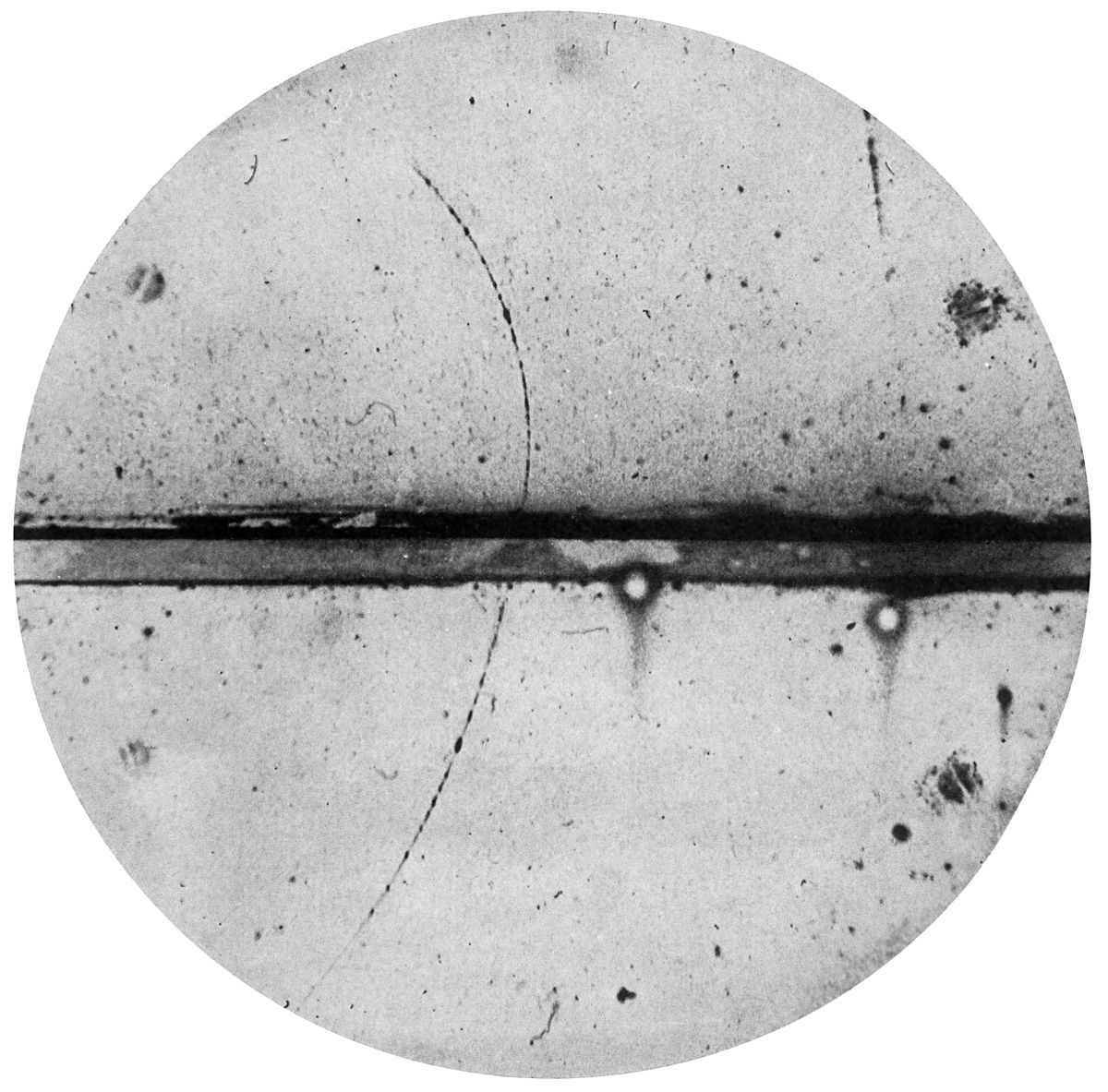Rosencrantz and Guildenstern aren't dead
Cloud chamber photograph of the first positron identified by Carl Anderson. The existence of such a particle (the anti-electron) was mentioned in passing by Dirac in his 1931 paper on quantization of electric charge.
2017 was a year of Big Science. The end of the Cassini mission, which was supported by hundreds of people over the years, and the remarkable coming-together of thousands of international scientists to study the first confirmed neutron star-neutron star merger, are two which readily spring to mind (possibly because I have been peripherally involved in both). The 2017 Nobel Prize for physics was awarded to Kip Thorne, Rainer Weiss and Barry Barish, but also recognises the work of the thousands of individuals who make up the LIGO collaboration, which has had phenomenal success detecting gravitational wave transients over the past couple of years.
Advances in technology and ease of collaboration, as well as the collection of vast amounts of data, are making it possible to ask Big Science Questions in astronomy. Questions like
What is Dark Matter?
What is Dark Energy?
How did the Universe become reionized?
How do galaxies evolve across cosmic time?
need big resources, and big teams to solve them. These are the current dominant narratives we see in popular science media, the protagonists of modern astronomy.
However, it’s worth remembering that often science happens in the wings of the main production. Sometimes, the science happening off-stage, in the background of the Big Discoveries, can have profound consequences.
Paul Dirac is widely regarded as one of the fathers of modern physics. His wave equation, which marries together special relativity and quantum mechanics, is taught to hundreds of thousands of physics students. The same physics students often hear anecdotes about Dirac himself, who by many standards (although perhaps not by those of academia) an unusual character. Dirac’s legacy and passion for precision and elegance can be seen in every young physicist who turns to astronomy, and is confronted for the first time with order of magnitude approximations and tildes.
The unusual thing about the initial publication that describes the relativistic wave equation (the Dirac equation) is that it contains a rather uncomfortable loose end. In the initial publication, Dirac points out the loose end: specifically, there are solutions which describe a particle with “negative energy”. Like Shakespeare sending Hamlet’s erstwhile childhood friends Rosencrantz and Guildenstern away on business (off stage, of course), it is a loose end that begs some kind of resolution.
This resolution only came several years later, in the rather philosophical introduction of Dirac’s 1931 paper “Quantised Singularities in the Electromagnetic Field”. As the name of the paper suggests, the search for a physical meaning of these “negative energy” solutions to the Dirac equation is not the main subject of the paper. In the introduction, Dirac muses on the recent developments in fundamental physics, noting that the new paradigm for advances in physics will be the development of abstract mathematical theories, which can then be matched to observed physical phenomena. This is still an avenue of research today, but there are still many physicists (myself included) trying to explain observations, as opposed to hunting down some fragment of evidence to match a cornucopia of mathematical theories.
The first description of antimatter* is almost a footnote to the main purpose of Dirac’s 1931 paper, reminiscent of the ambassador’s line that “Rosencrantz and Guildenstern are dead” in the final scene of Hamlet. It tidies up the concept that the negative energy solutions to the relativistic wave equation, describing the anti-electron (the term “positron” was coined by Carl Anderson a year later, the experimental discoverer of the particle). It is presented almost dismissively, with Dirac describing the annihilation probability of such a particle to be so high that they probably would not be observed in nature until significant technological advancements can be made. The de-emphasis of the whole idea, and the way the writing quickly moves past the point. It’s an interesting treatment of a concept that has possibly raised more questions than it has answered in the past 80-odd years.
The concept has been given a life of its own by hundreds of physicists over the years, with questions about antimatter ranging from the existential (why does the universe contain more antimatter than matter?) to the ridiculous (I received an email recently about antimatter stars in the Milky Way). Like Tom Stoppard’s play, most of the science of antimatter has occurred in the wings of the Big Science Narratives, occasionally encroaching onto the main stage. Unlike Tom Stoppard’s play (in my opinion), the study of antimatter in the universe is actually interesting. Of course, I may be a little biased.
Lots of blog posts have appeared in recent days about the Big Science Stories that people are looking forward to this year. I’m also looking forward to many of them. But I’m also looking forward to the small science stories. The “huh, that’s weird” stories that make you think again and remind you that while asking the big questions may be important, it’s often the little ones that keep you awake at night.
*The discoverer of antimatter, at least experimentally, is usually stated to be Carl Anderson. However, Soviet academic Dimitri Skobeltsyn, and, independently, Caltech graduate student Chung-Yao Chao found tracks in bubble chambers that behaved as an electron would, except they curved the opposite way. Both observations were dismissed as an error on the part of the experimentalists. I think these two individuals deserve acknowledgement.
Reference:
"Quantized singularities in the electromagnetic Field", P.A.M. Dirac
